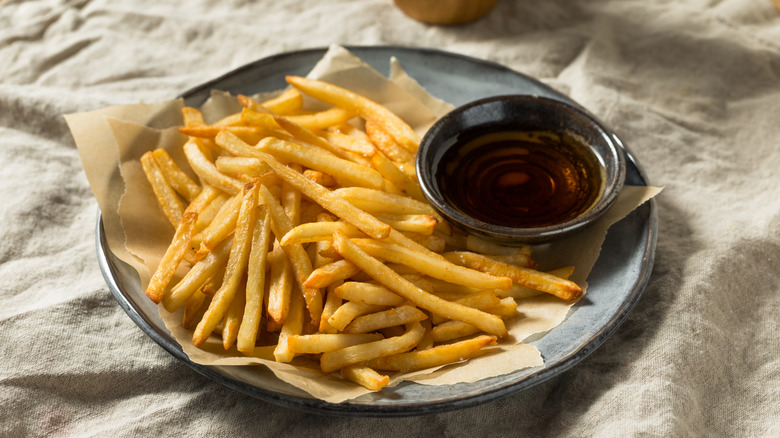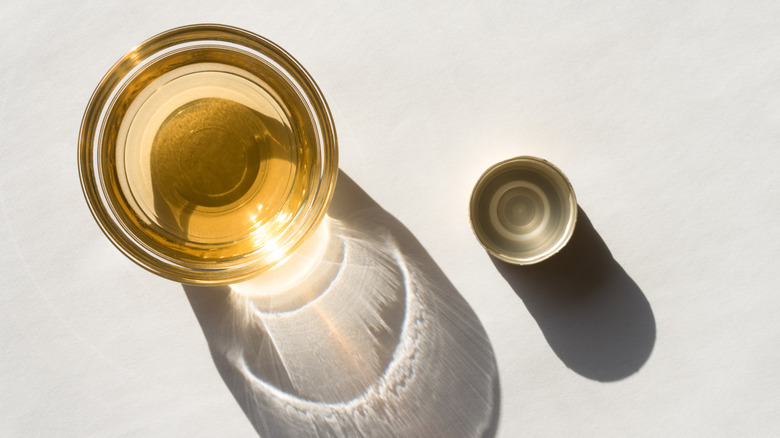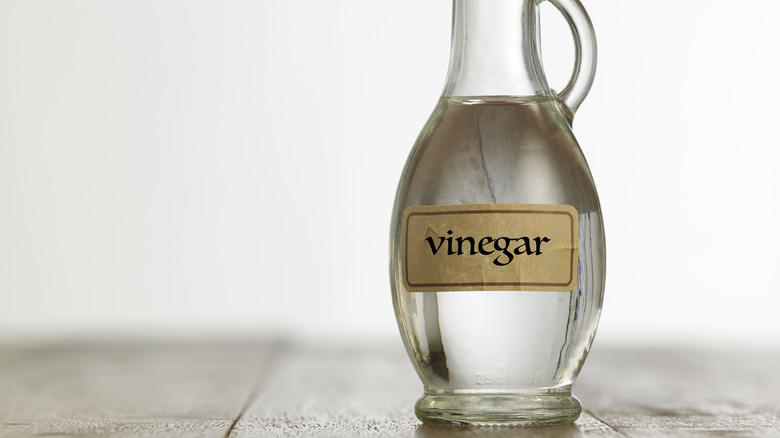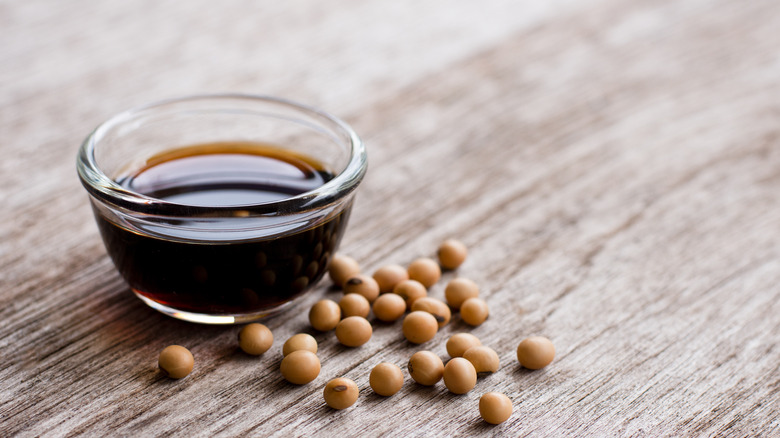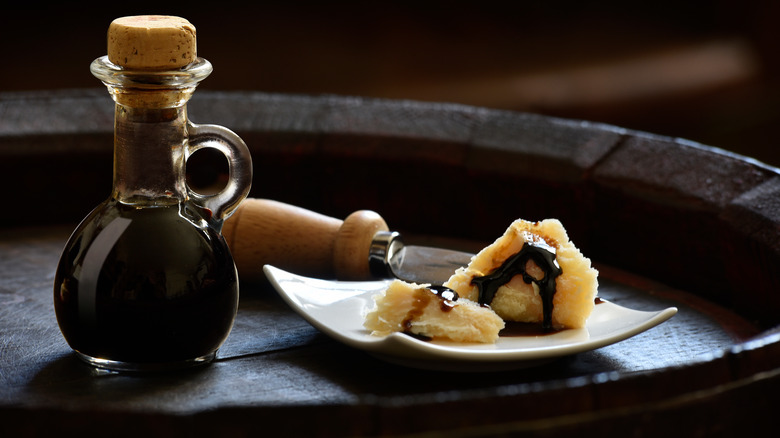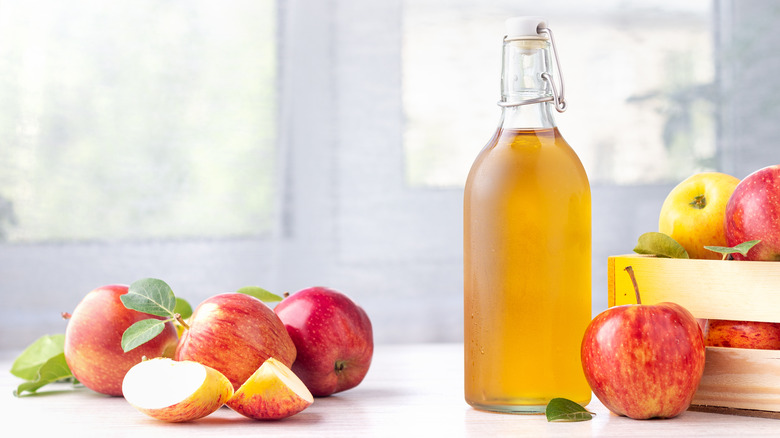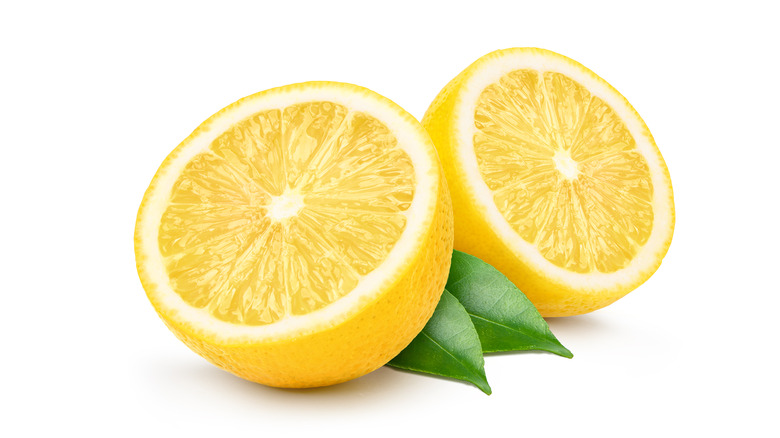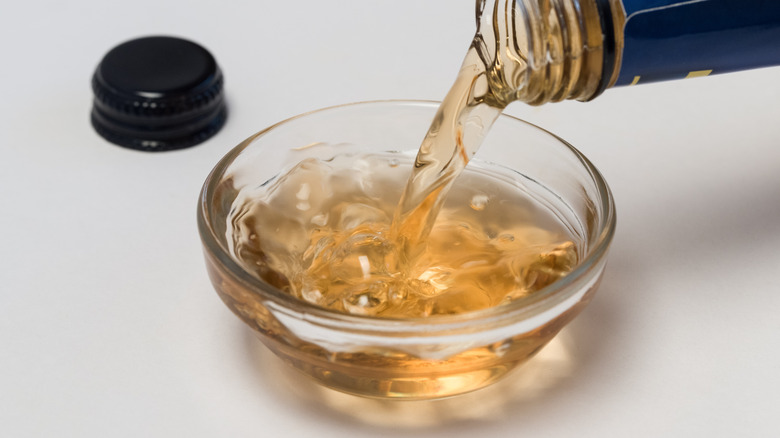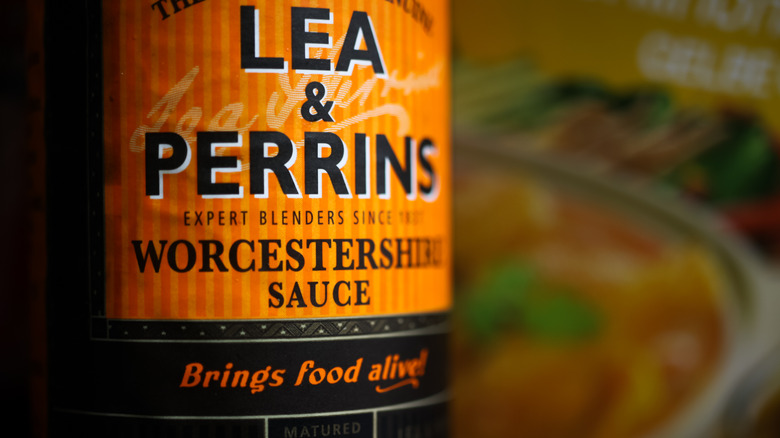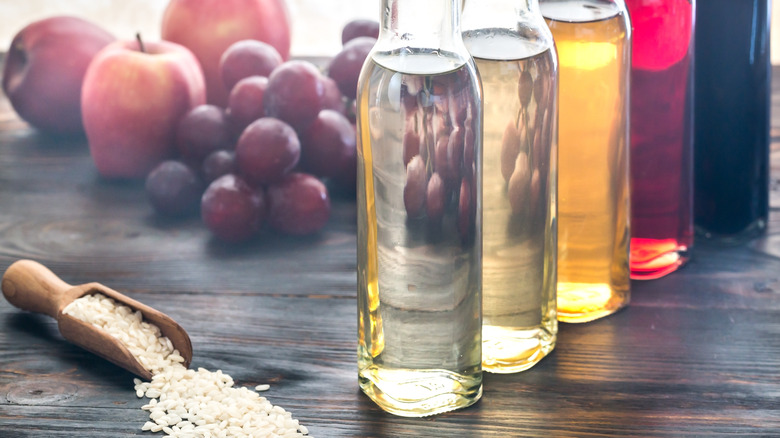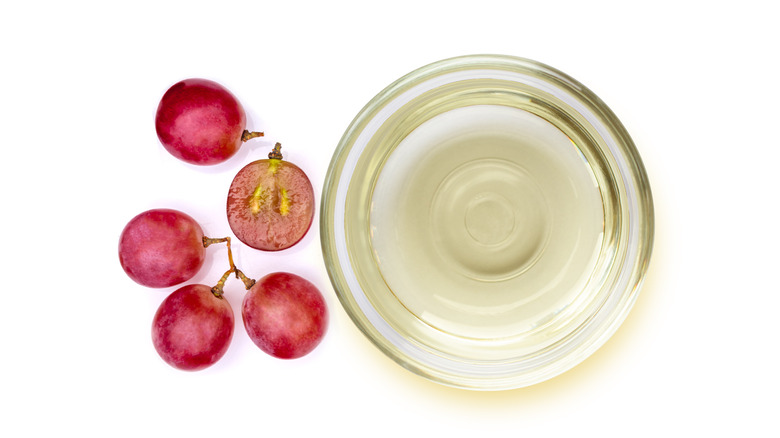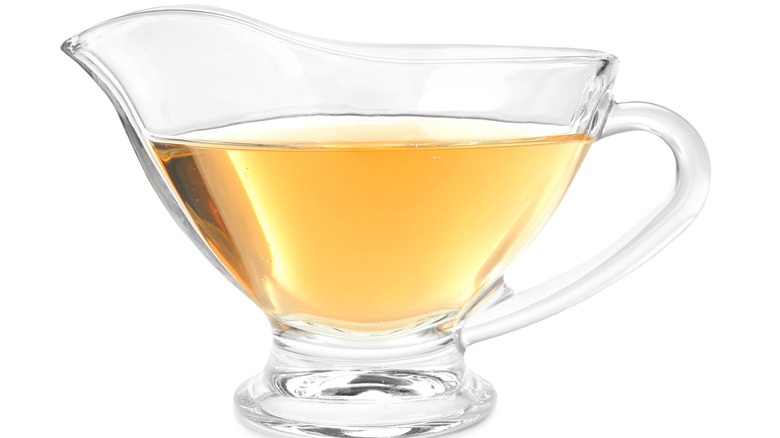The Absolute 11 Best Substitutes For Malt Vinegar
What has a deep golden, caramel color, and tastes amazing on fish and chips? Let's see, ketchup is red, and tartar sauce is white. Are you stumped yet? It's malt vinegar. Though used in Australia, Ireland, and Canada, malt vinegar might be the most popular across the pond in the UK where Brits use it in place of ketchup on "chips," which is their version of the french fry. Even better, malt vinegar is also used like tartar sauce on fish and chips.
So, what exactly is it about malt vinegar that rivals our beloved ketchup? Malt vinegar has a sharp, sour taste that provides a pop of dramatic flavor. This style of vinegar also has a slightly toasted, nutty flavor and is low in acidity. As SPICEography explains it, malt vinegar is made from ale or malted barley. Of course, the process of making malt vinegar itself is complex, but our focus is on the taste.
What if, like us, you don't live across the pond? What if (although available in most grocery stores), you want your golden fried, fish and chips recipe now, and you don't want to wait for a store run to grab malt vinegar to start digging in? Is there a malt vinegar substitute that could provide the same experience without having to leave the house? Yes, there are many, and we rounded up the best vinegar alternatives.
Champagne vinegar
Ooh, la la! Anytime we hear the word Champagne, we immediately think of France and a toasted celebration of high caliber. Though Champagne vinegar is made from (you guessed it) Champagne, it is accessible to anyone and can be found at most grocery stores. But, not just any grape will do: Champagne vinegar is made by only using chardonnay and pinot noir grapes. That's right, the same grapes used to make Champagne are being used to make the vinegar.
Champagne vinegar is light in color and so is the vinegar. It has a light, fruity flavor with woodsy hints because it is aged in oak barrels for up to two years. It carries a pungent pop of flavor and can hold up to the hints of toasted nuts in malt vinegar.
So, why then would we add it to our list as a good substitute for malt vinegar? It's low in acidity like malt vinegar, and because of its lightness, it's a great introduction if you are new to the idea of sprinkling vinegar on your food or are cautious to do so. For sprinkling on food start with a little and adjust to your liking. As a condiment, you might need a little more to reach the intensity of malt vinegar. For cooking, you can use a one-to-one ratio, which means, if a recipe calls for 1 tablespoon of malt vinegar, then use 1 tablespoon of Champagne vinegar.
White vinegar
Grandma comes to mind when we think of white vinegar because she didn't use blue window cleaner. Grandma used white vinegar and water for cleaning glass, and it worked quite well. Forget the small bottle, she went big. Because if she wasn't cleaning the windows, she was using white vinegar for making her famous bread-and-butter pickles. Grandma got how to use this multi-use product.
White vinegar is what happens when grain alcohol is exposed to oxygen. From there, acetic acid is made from bacteria that forms. Hmmm, maybe we don't need to know all the details. We just need to know that at the end of the fermentation process we get a white vinegar that is clear in color. White vinegar is also gluten free, available in larger bottles, and is lower in price — making it a great vinegar around the kitchen.
White vinegar has a ratio of one-to-one with malt vinegar in cooking recipes. However, if sprinkling on top of food, start with a small amount and add more as needed. Because the clear style is more sour and acidic, it's a good idea to taste test.
Soy sauce
Soy sauce is a treat for all the senses. It covers sweet, salty, bitter, and umami. What is umami exactly? It's that savory something you can't quite describe but can taste. The umami in Soy sauce is that pop of flavor, resulting in a solid substitute for malt vinegar. Soy sauce follows a fermentation process like vinegar does. Soybeans are soaked in water or steamed, then mixed with crushed wheat because the sugars in the grain are imperative to fermentation when mixed with helpful mold and bacteria. In the end, there are different types of soy sauce, but most are fermented for two to three years before their ready to be bottled and sold.
Soy sauce is an excellent choice for a malt vinegar substitute because its acidity can easily go toe-to-toe with malt vinegar at a one-to-one ratio. They also have a few things in common: a little goes a long way, both provide that pop of flavor we keep mentioning, and both are acidic.
But there is one difference that should be noted: Soy sauce is higher in sodium. So, when cooking with soy sauce, you will want to adjust the amount of salt in your recipe. In addition, when sprinkling on food, start with a little and adjust as needed. If you need a gluten-free soy sauce substitute, reach for tamari.
Balsamic vinegar
Balsamic vinegar dates back to as early as 1046 when given as a gift to the Roman Emperor. Italy couldn't keep its secret in a bottle for long. The country still plays an important role in the production of traditional balsamic vinegar. The Emilia-Romagna region is know as one of the two cities where the specialized vinegar is made.
True balsamic vinegar is only made from grapes and is aged for no less than 12 years and upwards of 25 years. When buying this malt vinegar substitute, there will likely be a wide range in prices. The less costly balsamic vinegar choices will have a more acidic and tangier taste with less sweet notes. So, if the traditional sweet taste is what you are looking for, choose a better quality balsamic.
Balsamic vinegar is like a thick syrup, whereas malt vinegar is more fluid. Malt vinegar is also stronger in flavor with hints of malted ale while balsamic has more of a balance between sweetness and acidity. So, balsamic is a milder vinegar flavor with a bit of a bitter aftertaste. Balsamic vinegar is more traditionally used as a drizzle or in a vinaigrette. It can be also used on a one-to-one ratio if replacing malt vinegar in a recipe. And if looking for vinegar to drizzle over your fried foods, like malt vinegar, balsamic would be a great choice thanks to its sweeter side.
Apple cider vinegar
Apple cider vinegar goes through a fermentation process similar to that of other vinegars. Apples are covered with water and left to ferment over time into acetic acid. When the process is finished, we have vinegar with that sharp hit of acidity and flavor that can make you pucker. You will also get hints of apple and a bit of sweetness to round things off.
It's hard to find a health magazine that doesn't have an article about all the potential benefits apple cider vinegar could hold. These articles make apple cider vinegar sound as if it's the latest and greatest, but apple cider vinegar isn't new at all. This vinegar has a very long history dating all the way back to 400 BC. As SPICEography explains, apple cider vinegar was used to treat coughs and colds, as well as a digestive remedy. Roman soldiers believed it increased strength on the battlefield, and therefore, made a diluted apple cider vinegar water to keep them hydrated.
Of course, a lot has happened since then, but one thing is for sure, apple cider vinegar isn't going anywhere. So, the next time you run out of malt vinegar, consider reaching for the apple cider vinegar, or ACV, as the cool kids are calling it. At a one-to-one ratio, apple cider vinegar can be substituted in your cooking in place of malt vinegar.
Lemon juice
Is there anything that lemon hasn't made better? From meringue pie to garlic chicken, this citrus can get along with just about everything. Lemon pairs well with so many foods, that perhaps its most striking characteristic gets lost: simplicity. A squeeze of lemon can do marvelous things for taste buds all on its own. A little zesting here and a little squeeze there and complexity arises. No more flat or boring-tasting food when lemon is around.
There is one fact we can't deny: Lemon juice is not vinegar. The two still have much in common, though. Both malt vinegar and lemon have acidity, that burst of sour that wakes us up. They also each have a mellow finish — once you get past the initial shock, you can pick up the other flavors. For malt vinegar, it's a toasted nuttiness with hints of ale. For lemon juice, those hints include citrus and a sweet finish. The two aren't identical, but we know lemon will not disappoint.
Regarding substitutions for cooking, you will need to double the amount of lemon juice. So, if a recipe calls for 1 teaspoon malt vinegar then use 2 teaspoons lemon juice.
Sherry vinegar
When we hear the name Sherry, you might start to hum the catchy tune by The Four Seasons. The sherry we are discussing today, however, is of the vinegar variety. Sherry vinegar is produced in Spain's Jerez region, to be exact. It's the only location where sherry wine and sherry vinegar can be made for mass production and has been since at least the 16th century. The aging process will take anywhere from six months to 20 years for the flavor profile to fully develop. When ready, the flavor of sherry vinegar is deep, nutty, and offers a hint of sweetness.
Gourmet Sleuth explains that wine was introduced to Spain by Greek travelers somewhere between the fifth and sixth centuries. So, we owe them a big thank you. They could very well be the reason Spain took up wine-making themselves. We'd like to guess that Spain used the time gap between centuries to perfect their wine-making skills, which later turned into perfecting their sherry vinegar making skills.
Sherry vinegars deep flavor and nutty undertones make it a suitable substitute for malt vinegar. For cooking, it can measured at a one-to-one ratio. When sprinkling over food, start small and add more as needed.
Worcestershire
Worcestershire sauce originated in England in the town of its namesake, Worcestershire. This unique sauce has an ingredient list as long as our arm: molasses, sugar, anchovies, cloves, soy, vinegar, and garlic. We're not sure if the combination is a recipe, potion, or experiment. Either way, we're left with a flavorful and complex sauce.
Do you recall the popular commercial for Worcestershire sauce where the slogan went something like this, "Shaky, shaky, wakey, wakey...."? That slogan has been forever seared in our minds. Every time we see a bottle of Lea and Perrins Worcestershire sauce that slogan starts to go on auto-play. Why is this relevant? As the story goes, John Lea and William Perrins, both chemists, were the original inventors of what we know today as Worcestershire sauce. They tasted the first batch, and it was all wrong, so they threw the sauce away. The chemists then forgot about the extra barrels in the basement. But, when they later tasted the fermented batch, the duo knew they had a winner.
Due to its pungent and deep flavor, Worcestershire is a natural choice for a malt vinegar substitute. It has that "wow" factor when you first taste it, as well as that savory something as described as umami. A little sweet, a little sour, a little salty, this sauce offers the wake-up call Lea and Perrins rhymed about in its commercials. Regarding measurements, start with half the recommended amount of malt vinegar and adjust upward to taste.
Rice wine vinegar
Rice wine vinegar and rice vinegar are the same. They are not to be confused, however, with the drinkable varieties because rice wine and sake are different, after all. Hanging with friends, sharing sushi, conversation, and sipping rice wine or sake might be delightful. Though considered mild, rice wine vinegar is still too pungent for drinking but perfect for fish and chips.
To give you a little history, according to All About Sushi Guide, rice vinegar was first recorded around 1200 B.C. in China and in Japan around 794. Samurai warriors drank this vinegar as a tonic because they believed that it would enhance their abilities, such as strength and power. You likely guessed it: Rice vinegar is made from fermented rice. MasterClass says alcohol is created from the sugars in the rice, and from there, the vinegar is formed once turned into alcohol. If you are wondering what rice wine vinegar tastes like, it can be described as mild, sweet, and with low acidity.
For cooking, rice vinegar is traditionally mixed with soy sauce or sesame. However, because of its mild acidity, light flavor, and hint of sweetness, rice wine vinegar can also be used in a variety of recipes. Start with the one-to-one ratio and adjust accordingly to taste.
White wine vinegar
It's hard to talk about white wine vinegar without first discussing the many types of white wine available. Have a special occasion? There's a white wine for that. Have a special recipe? White wine will likely be a perfect pairing. With white wine's reputation for crisp and light varietals, it's no wonder that those same attributes would make it a wonderful vinegar choice as well.
White wine vinegar is made a bit differently than distilled vinegar. Distilled vinegar is made from grain alcohol, like vodka. White wine vinegar being made from wine makes for a milder, sweet flavor, and a light gold color. As Recipe Lion explains it, the flavor of the original wine grapes are retained in the acid in the vinegar.
White wine vinegar will still have the same crisp and powerful first hit of flavor as malt vinegar, but as the flavor subsides, more mellow and light notes will emerge. Also, use the traditional one-to-one ratio when substituting for malt vinegar. Due to white wine vinegar's milder flavor, you may choose to sprinkle on a little more.
Cane vinegar
This malt vinegar replacement comes from a region in North Philippines. Cane vinegar is a type of vinegar commonly used in Filipino cuisine and is made from molasses, which comes from sugar cane, hence the name. What is molasses? It's the syrup left over after the sugar crystals have been boiled down. Note that CooksInfo tells us that cane vinegar is made in other areas of the world like the state of Louisiana and France. It's a rather new industry for Louisiana, but since it has sugar cane fields, local makers thought they would give it whirl. France also makes a version of molasses and imports its sugar cane juice from Martinique.
As explained by Epicurious, fermented cane vinegar is specific to Ilocos, which is in North Philippines. The process differs from a more industrial environment because fermentation occurs in jars and are sealed with banana leaves.
Cane vinegar is not sweet despite the fact it comes from a by-product of sugar cane. Its acidity and strong flavor cannot be missed, but it is still more mellow than malt vinegar and is more like sherry vinegar in comparison. This makes it great for dipping or sprinkling on fish and chips. To use cane vinegar in place of malt vinegar, it can be used at a one-to-one ratio. For sprinkling over food, add more if needed.
